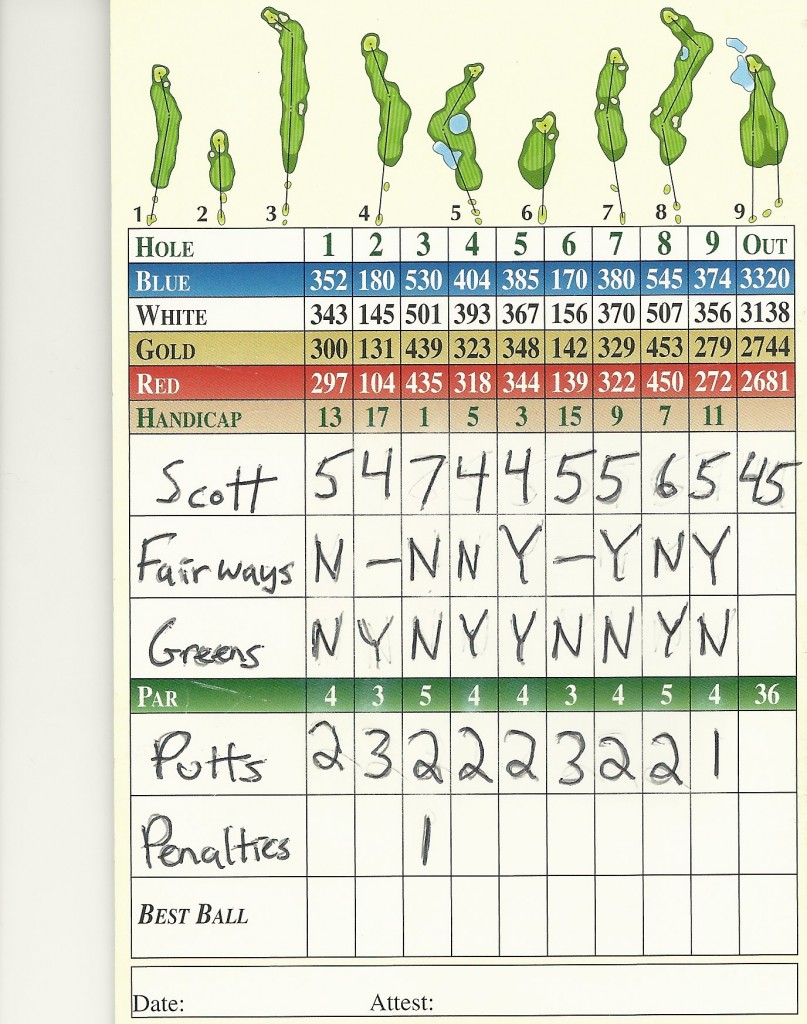Wow, over ten years ago already, I wrote about How Statistics Can Improve Your Golf Game. I used to track basic stats for all my rounds. The stats included the big three at the time – fairways hit, greens in regulation, and number of putts. One extra stat was number of penalty strokes. Eliminating penalty strokes is impossible, but greatly reducing them is the fastest way for a beginner or high-handicap golfer to lower their scores.

I had big intentions of making a website where I could analyze my stats. I eventually hoped to share it with other golfers. The website never came to fruition, but I did learn a great deal about my game through consistently keeping stats.
Still, I felt back then when I wrote that post that these stats could be misleading.
I’m assuming we all have mishit a driver off the tee, with it barely making it to the fairway. Even though we may have only hit our driver 100 yards, we still get to check the box that we hit the fairway.
Number of putts must be the most unreliable stat. We could have a low number of putts for the round, with it only meaning we missed every green and chipped it close. Our putting wasn’t good. Our short game was. Or, we could have large number of putts after hitting every green in regulation. Our putting may have been very good, but we started 30 feet away on many greens.
Out of the big three stats, greens in regulation may have been the most reliable gauge for the state of your game. If you hit a green in regulation, giving yourself a birdie putt, you can read at least a few things into it. First, regardless of whether you hit the fairway or not, you put your drive in a place where you had a decent look at your second shot. From there, on a par 4, you hit a good enough shot to put your ball on the green. On a par 5, you at minimum hit a combination of your next two shots that ended up with your ball on the green.
The PGA Tour stopped using these stats a long time ago. They knew there had to be a better way. Twenty years ago, they began logging every shot for every player in almost every tournament, in a system they named ShotLink.
Mark Broadie, a professor at Columbia Business School, developed the Strokes Gained method of stat keeping, using all this PGA Tour shot data as the benchmark. By using the millions of shots in ShotLink, the average number of shots needed by PGA Tour players to finish a hole can be calculated from any distance and position (tee, fairway, rough, sand). Using these numbers, a player’s “strokes gained” on the field can be determined for every shot.
Here’s one quick example. Let’s say on average it takes 3.9 strokes for PGA Tour players to get the ball in the hole from 360 yards off the tee. You hit your drive 200 yards in the fairway. The average strokes to get in the hole for PGA Tour players from 160 yards in the fairway is 3.
Using the following formula:
(Average strokes at starting point) – (Average strokes at ending point) – 1 (for your shot) = Your Strokes Gained for that shot
Strokes gained can either be positive for a good shot or negative for a bad shot.
We would find that 3.9 – 3 – 1 = -.1 Strokes Gained. You would have lost .1 strokes on your drive against the PGA Tour average.
You can use this methodology for strokes gained off the tee, strokes gained tee to green, strokes gained around the green, and strokes gained putting. The beauty of stroked gained is that in each of these categories, the unit is strokes. This enables you to add your strokes gained on shots together, to have stats like strokes gained on the hole, strokes gained on the round, and total strokes gained.
I encourage you to read Mark Broadie’s excellent book, Every Shot Counts – Using the Revolutionary Strokes Gained Approach to Improve Your Golf Performance and Strategy, for much more information on strokes gained.
With the abundance of shot tracking products now available, amateurs can easily track their own strokes gained. Arccos Smart Caddie and the Shot Scope X5 are just two examples. With the large amount of amateur shot data these systems have collected, you can also use various handicap levels as your benchmark instead of PGA Tour golfers.
I’d like to build my own mobile app to track my own shots gained, tracking enough of my own shot data so I can use myself as the benchmark. After all, the only golfer or person I need to be better than tomorrow than I was today, is myself.
While we should be tracking meaningful stats for our golf game, we more importantly should be careful not to compare ourselves to the world, but instead follow the perfect example that Jesus provided for us.
In his first letter, the apostle John states we are in and remain in Jesus when we walk in his ways.
Whether you are on the golf course, in your home, at your job, or anywhere out in the world, strive to walk in the ways of Jesus.
